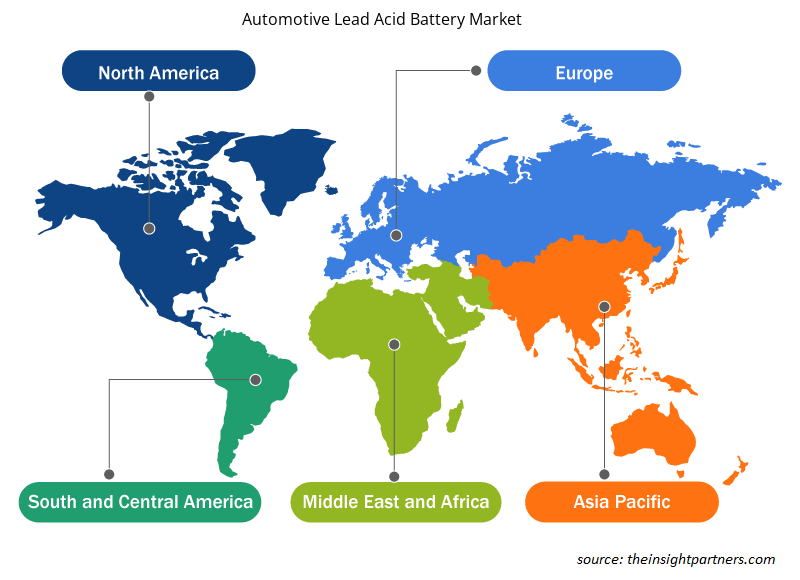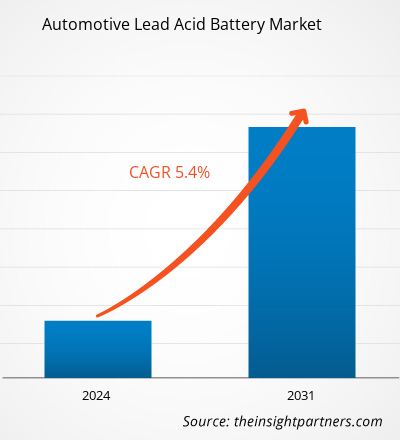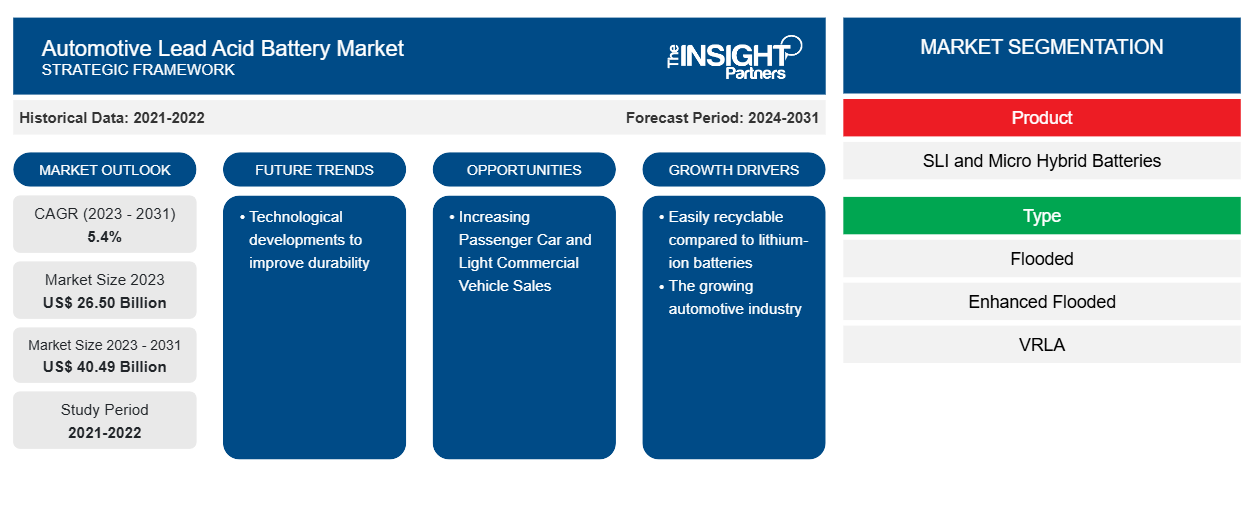Le marché des batteries plomb-acide pour automobiles devrait passer de 26,50 milliards de dollars américains en 2023 à 40,49 milliards de dollars américains en 2031 ; il devrait croître à un TCAC de 5,4 % de 2023 à 2031. Le développement technologique visant à améliorer la durabilité devrait être une tendance clé du marché.CAGR of 5.4% from 2023 to 2031. Technological development to improve durability is anticipated to be a key trend in the market.
Analyse du marché des batteries au plomb pour automobiles
Comparées aux autres types de batteries rechargeables, les batteries au plomb-acide sont moins chères. Le taux d'autodécharge de cette batterie est d'environ 40 % par an. Une batterie au plomb-acide fonctionne efficacement à la fois à haute et à basse température. La technologie utilisée dans ces batteries est mature. Une batterie au plomb-acide, lorsqu'elle est utilisée correctement, peut durer longtemps et fournir un service fiable. Les batteries au plomb-acide peuvent fournir des courants de surtension importants, ce qui les rend idéales pour les applications nécessitant une explosion rapide de puissance, telles que les batteries de démarrage automobile. Ainsi, la demande de batteries au plomb-acide pour automobiles devrait augmenter au cours de la période de prévision.
Aperçu de l'industrie du marché des batteries au plomb pour automobiles
Une batterie plomb-acide pour automobile est un dispositif rechargeable qui stocke l'énergie électrique sous forme d'énergie chimique. Elle est composée de nombreuses cellules connectées en série, chacune contenant une série de plaques de dioxyde de plomb et de plomb spongieux immergées dans une solution d'acide sulfurique. Les batteries plomb-acide fonctionnent efficacement dans diverses situations climatiques . Elles ont une puissance de démarrage élevée, fournissant un courant de démarrage adéquat même dans des températures extrêmes. Cette caractéristique fait des batteries plomb-acide un excellent choix pour les automobiles dans les climats froids et chauds. Ainsi, la demande de batteries plomb-acide devrait augmenter au cours de la période de prévision.
Personnalisez ce rapport en fonction de vos besoins
Vous bénéficierez d'une personnalisation gratuite de n'importe quel rapport, y compris de certaines parties de ce rapport, d'une analyse au niveau des pays, d'un pack de données Excel, ainsi que d'offres et de remises exceptionnelles pour les start-ups et les universités.
-
Obtenez les principales tendances clés du marché de ce rapport.Cet échantillon GRATUIT comprendra une analyse de données, allant des tendances du marché aux estimations et prévisions.
Moteurs et opportunités du marché des batteries au plomb pour automobiles
Les batteries au plomb-acide sont facilement recyclables par rapport aux batteries au lithium-ion, ce qui favorise la croissance du marché.
Le recyclage des batteries consiste à éliminer soigneusement et à neutraliser l'acide sulfurique des batteries usagées. Cette procédure limite le rejet d'acide sulfurique dangereux dans l'environnement, réduisant ainsi le risque de contamination des sols et des eaux. Les batteries lithium-ion ne contiennent pas de produits chimiques toxiques, contrairement aux batteries plomb-acide. Ces deux types de batteries sont recyclables. Cependant, les batteries plomb-acide sont plus facilement recyclables dans la plupart des régions du monde que les batteries lithium-ion. Environ 95 % des matériaux des batteries plomb-acide sont recyclables, ce qui en fait un choix respectueux de l'environnement. Ainsi, la demande de batteries plomb-acide devrait augmenter au cours de la période de prévision.
Augmentation des ventes de voitures particulières et de véhicules utilitaires légers
Selon l'article publié dans l'Economic Times, les ventes en gros de voitures particulières en Inde ont atteint un nouveau record de 42 18 746 unités au cours de l'exercice 2023-24. En outre, selon l'Association chinoise des constructeurs automobiles, les exportations chinoises de véhicules utilitaires ont atteint 74 000 unités en janvier 2024. Les batteries au plomb-acide sont préférées pour le démarrage, l'éclairage et l'allumage (SLI) d'une automobile. Ainsi, l'augmentation des ventes de véhicules particuliers et utilitaires légers devrait stimuler la demande de batteries au plomb-acide au cours de la période de prévision.SLI) in an automobile. Thus, increasing sales of passenger and light
Analyse de segmentation du rapport sur le marché des batteries au plomb pour automobiles
Les segments clés qui ont contribué à l’élaboration de l’analyse du marché des batteries plomb-acide automobiles sont le produit et l’utilisateur final.
- En fonction du produit, le marché est divisé en batteries SLI et micro-hybrides.SLI and micro-hybrid batteries.
- en fonction du type, le marché est segmenté en inondé, inondé amélioré et VRLA)VRLA)
- En fonction des utilisateurs finaux, le marché est segmenté en voitures particulières, véhicules utilitaires légers, véhicules utilitaires légers et véhicules utilitaires lourds.
- En 2023, le segment SLI représentait une part de marché importante. La batterie SLI est une batterie plomb-acide rechargeable et elle est largement utilisée dans différentes automobiles.
Analyse des parts de marché des batteries au plomb pour automobiles par zone géographique
En fonction des régions, le marché est segmenté en Amérique du Nord, Europe, Asie-Pacifique, Moyen-Orient et Afrique, et Amérique du Sud et centrale.
La forte présence de l'Europe dans l'innovation automobile et les mesures environnementales a un impact considérable sur l'industrie des batteries plomb-acide pour automobiles. L'Allemagne, le Royaume-Uni et la France devraient être les principaux pays du marché européen des batteries plomb-acide pour automobiles. D'autre part, l'Asie-Pacifique devrait être le marché le plus rentable au cours de la période de projection en raison de la croissance du secteur automobile dans la région.
Aperçu régional du marché des batteries au plomb pour automobiles
Les tendances régionales et les facteurs influençant le marché des batteries au plomb pour automobiles tout au long de la période de prévision ont été expliqués en détail par les analystes d’Insight Partners. Cette section traite également des segments et de la géographie du marché des batteries au plomb pour automobiles en Amérique du Nord, en Europe, en Asie-Pacifique, au Moyen-Orient et en Afrique, ainsi qu’en Amérique du Sud et en Amérique centrale.

- Obtenez les données régionales spécifiques au marché des batteries au plomb-acide pour automobiles
Portée du rapport sur le marché des batteries au plomb pour automobiles
| Attribut de rapport | Détails |
|---|---|
| Taille du marché en 2023 | 26,50 milliards de dollars américains |
| Taille du marché d'ici 2031 | 40,49 milliards de dollars américains |
| Taux de croissance annuel composé mondial (2023-2031) | 5,4% |
| Données historiques | 2021-2022 |
| Période de prévision | 2024-2031 |
| Segments couverts |
Par produit
|
| Régions et pays couverts |
Amérique du Nord
|
| Leaders du marché et profils d'entreprises clés |
|
Densité des acteurs du marché des batteries au plomb pour automobiles : comprendre son impact sur la dynamique commerciale
Le marché des batteries au plomb pour automobiles connaît une croissance rapide, tirée par la demande croissante des utilisateurs finaux en raison de facteurs tels que l'évolution des préférences des consommateurs, les avancées technologiques et une plus grande sensibilisation aux avantages du produit. À mesure que la demande augmente, les entreprises élargissent leurs offres, innovent pour répondre aux besoins des consommateurs et capitalisent sur les tendances émergentes, ce qui alimente davantage la croissance du marché.
La densité des acteurs du marché fait référence à la répartition des entreprises ou des sociétés opérant sur un marché ou un secteur particulier. Elle indique le nombre de concurrents (acteurs du marché) présents sur un marché donné par rapport à sa taille ou à sa valeur marchande totale.
Les principales entreprises opérant sur le marché des batteries plomb-acide pour automobiles sont :
- Clarios
- CSB Energy Technology Co., Ltd.
- EnerSys
- Entreprise de fabrication de l'est de la Pennsylvanie
- Exide Industries Limitée
- GS Yuasa International Ltd.
Avis de non-responsabilité : les sociétés répertoriées ci-dessus ne sont pas classées dans un ordre particulier.

- Obtenez un aperçu des principaux acteurs du marché des batteries au plomb pour automobiles
Actualités et développements récents du marché des batteries au plomb pour automobiles
Le marché des batteries au plomb pour automobiles est évalué en collectant des données qualitatives et quantitatives après des recherches primaires et secondaires, qui comprennent d'importantes publications d'entreprise, des données d'association et des bases de données. Quelques-uns des développements dans le domaine des batteries au plomb pour automobiles sont répertoriés ci-dessous :
- GS Yuasa Corporation a annoncé que Tata AutoComp GY Batteries Private Ltd. (« TGY »), une société basée en Inde et filiale à participation égale de la filiale GS Yuasa International Ltd. (« GS Yuasa »), vise à doubler sa capacité de production annuelle de batteries plomb-acide pour motos à 8,4 millions d'unités. En outre, TGY renforcera sa production de batteries plomb-acide pour automobiles, en mettant l'accent sur les batteries plomb-acide hautes performances pour les véhicules respectueux de l'environnement, tels que les véhicules Start & Stop, dont la demande devrait continuer à croître dans les années à venir. (Source : GS Yuasa Corporation, communiqué de presse, décembre 2021)
Rapport sur le marché des batteries au plomb pour automobiles et couverture des livrables
Les prévisions du marché des batteries au plomb pour automobiles sont estimées sur la base de diverses conclusions de recherche secondaires et primaires, telles que les publications clés des entreprises, les données des associations et les bases de données. Le rapport de marché « Taille et prévisions du marché des batteries au plomb pour automobiles (2021-2031) » fournit une analyse détaillée du marché couvrant les domaines ci-dessous-
- Taille et prévisions du marché des batteries au plomb pour automobiles aux niveaux mondial, régional et national pour tous les segments de marché clés couverts par le champ d'application
- Tendances du marché des batteries au plomb pour automobiles, ainsi que la dynamique du marché, comme les facteurs déterminants, les contraintes et les opportunités clés
- Analyse détaillée des cinq forces de PEST/Porter et SWOT
- Analyse du marché des batteries au plomb pour automobiles couvrant les principales tendances du marché, le cadre mondial et régional, les principaux acteurs, les réglementations et les développements récents du marché
- Analyse du paysage industriel et de la concurrence couvrant la concentration du marché, l'analyse de la carte thermique, les principaux acteurs et les développements récents sur le marché des batteries au plomb pour automobiles
- Profils d'entreprise détaillés.
- Analyse historique (2 ans), année de base, prévision (7 ans) avec TCAC
- Analyse PEST et SWOT
- Taille du marché Valeur / Volume - Mondial, Régional, Pays
- Industrie et paysage concurrentiel
- Ensemble de données Excel
Rapports récents
Rapports connexes
Témoignages
Raison d'acheter
- Prise de décision éclairée
- Compréhension de la dynamique du marché
- Analyse concurrentielle
- Connaissances clients
- Prévisions de marché
- Atténuation des risques
- Planification stratégique
- Justification des investissements
- Identification des marchés émergents
- Amélioration des stratégies marketing
- Amélioration de l'efficacité opérationnelle
- Alignement sur les tendances réglementaires























 Obtenez un échantillon gratuit pour - Marché des batteries au plomb pour automobiles
Obtenez un échantillon gratuit pour - Marché des batteries au plomb pour automobiles